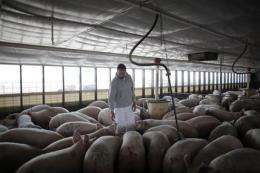US moving closer to swine flu vaccine

(AP) -- Inching closer to a swine flu vaccine, the government is beginning to analyze two candidates for the key ingredient to brew one. The Centers for Disease Control and Prevention hopes to deliver one or both to vaccine manufacturers by the end of next week so they can begin the months-long process of producing shots.
Friday, the government set aside $1 billion for crucial testing of the first pilot doses and stockpiling of key ingredients - in case world health authorities decide that people indeed need to be vaccinated starting sometime next fall.
Also on Friday, CDC scientists unveiled the most detailed genetic examination yet of the novel virus, finding that the new swine flu may have been circulating undetected in pigs for years.
That report, in the journal Science, still fails to solve the bigger mystery of when and where the virus made the jump to people and what genetic change allowed it to start spreading so rapidly. The virus was first detected last month, and at least 42 countries now have confirmed it in more than 11,000 people. At least 85 people have died from it.
The confirmed cases don't represent anywhere near the full scope of the outbreak: For every reported case of swine flu, there may be 20 people sickened with it, said CDC's Dr. Anne Schuchat - more than 100,000 people in the U.S. There are signs that it is declining in parts of the country, although school-related outbreaks in New York City and elsewhere have led to the closings of about 60 schools affecting 42,000 students, Schuchat said.
The candidate vaccine viruses the CDC has begun analyzing contain a mix of genes from the new swine flu virus itself with components of other viruses that allow them to grow better in the eggs that manufacturers use to produce vaccine. If one or both prove usable, manufacturers could begin producing pilot lots for testing this summer to see if the shots are safe, trigger immune protection and require one dose or two.
Influenza is a master of evolution, a quick-change artist that can rapidly swap genes to create new strains. Birds are the ultimate origin of influenza viruses, said CDC flu chief Nancy Cox, a senior author of the gene paper in Science.
But Type A flu viruses have long circulated in pigs, too, dating to when the infamous 1918 pandemic strain was introduced to swine. All three global flu epidemics of the past century passed on traits to ancestors of this new flu. Among those ancestors was a triple-strain, or "triple reassortment," as scientists call it - part pig, part bird, part human - that first hit U.S. pig farms in 1998. Others are traced to pig viruses in Europe and Asia.
In fact, viruses with genes that most resemble the new swine flu - known scientifically as part of the H1N1 influenza family - were identified 10 years ago. And a human case in Thailand in 2005 was found to share genes from both the North American and Eurasian swine flu lineages, but not in the exact never-before-seen genetic combination that this new flu contains, Cox said.
Pig populations around the world need to be more closely monitored for emerging influenza viruses, the CDC-led team concluded. The researchers have asked veterinarian colleagues around the world to check their freezers for samples from pigs or other animals that might help narrow down how the new flu made the species jump to people. It could have involved yet another intermediate animal host, Cox noted.
On the good side, the 51 virus samples from Mexico and the U.S. that the team analyzed were all very similar, in both their genetic characteristics and the way they interact with immune-system cells. That makes hunting a usable vaccine easier, Cox said.
---
On the Net:
Science: http://www.sciencemag.org
©2009 The Associated Press. All rights reserved. This material may not be published, broadcast, rewritten or redistributed.
















